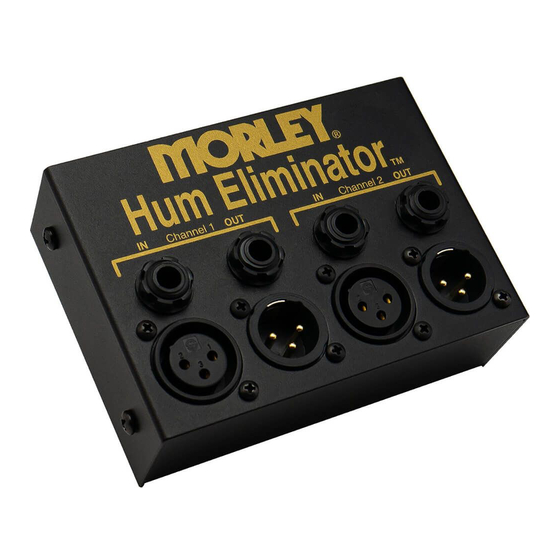
Advertisement
Silence AC Hum, forever! Do you hear a hum or buzz in your audio signal? Are long unbalanced lines across stage creating
noise problems? Get the Hum Eliminator™ from Morley®.
Almost all AC hum (60Hz in the US, 50 Hz in most other countries), is caused by ground loops. These ground loops act like
radio antennae picking up hum and noise. The Hum Eliminator™ completely eliminates this by breaking the ground loop,
making it impossible for the signal lines to pick up the AC hum and noise in the first place.
Just plug the Hum Eliminator™ in the signal lines between the offending pieces of equipment and you're done! Quick and
easy. No buzz, no hum. No signal degradation. No filtering. No noise gates. No dangerous ground lifts.
• Eliminates AC hum / 60Hz buzz and noise, quick and easy
• Breaks ground loop safely, while leaving all signal grounds intact
• Automatically translates signal voltages to match differences in
ground potentials, avoiding clipping
• Converts automatically back and forth between balanced and
unbalanced lines at either end
• Morley Engineered Custom 1:1 Isolation Transformers
• Completely passive design with audiophile quality components
assures the best possible performance
• Frequency response 20Hz to 70kHz plus or minus 0.5dB
• Distortion less than 0.005% THD @ 1kHz
• Crosstalk better than –97dB
• Maximum source impedance 1kOhm. Minimum load impedance
10kOhm
• Cold Rolled Steel Housing
• One Year warranty
GETTING STARTED:
WHAT WILL THE HUM ELIMINATOR™ SOLVE? The Hum Eliminator™ is a unity gain signal and ground path isolator
designed to break ground loops. Hum and noise caused by the presence of a ground loop can be stopped by inserting the
Hum Eliminator™ in the line level signal path (+4dBu or -10dBV). This eliminates the ground loop without degrading your
signal. The Hum Eliminator™ will not reduce hum or noise normally generated by a piece of equipment. In other words,
for noisy preamps, noisy single coil pickups or noise caused by faulty tubes, other corrective action would apply.
USING THE HUM ELIMINATOR™: First, identify the cause of the ground loop. Note: not all ground loops cause noise or
hum. For complex systems, you may need to repeat these steps starting with a different piece of equipment in various
combinations to locate the problem:
1) Strip the system down to one piece, by disconnecting all interconnects and AC cords except for the mixer.
2) Add one piece of equipment at a time; hook up AC and interconnects then listen for hum or noise.
3) Turn on and off the power each time you add equipment to avoid pops / shorted outputs.
4) Proceed until you find the offending piece(s) causing the problem.
5) Insert the Hum Eliminator™ on all cable connection between the offending equipment.
Note: Never use the Hum Eliminator™ between an amplifier and speaker or you will damage your equipment. Use
only on non-powered line level signals.
With a rack of amplifiers, we recommend putting multiple Hum Eliminators™ in front of your amps inputs so you do not
have to solve ground loop problems during sound checks. A common path for ground loops is through a chassis into the
rack and then into another chassis. Test this by removing the chassis from the rack. The Hum Eliminator™ will help this
problem but you should also try isolating the chassis from the rack with electrical tape or insulating the rack screws with
nylon washers. Most ground loop problems can be solved using the Hum Eliminator™ but patience is a necessity when
attempting to diagnose the cause of ground loop! Many popular mixers with TRS balanced line inputs do not have common
mode rejection. They drop the inverted signal, creating unbalanced inputs! To get the benefits of balanced inputs, run your
balanced line into the Hum Eliminator™ and run a mono 1/4" line from the Hum Eliminator™ outputs to the mixer's TRS inputs.
This way you are running a balanced line all the way up to the Hum Eliminator™ and you will not lose common mode
rejection.
Hum Eliminator™ User Instructions
Advertisement
Table of Contents

Summary of Contents for MORLEY Hum Eliminator
- Page 1 Hum Eliminator™ and run a mono 1/4" line from the Hum Eliminator™ outputs to the mixer's TRS inputs. This way you are running a balanced line all the way up to the Hum Eliminator™ and you will not lose common mode...
- Page 2 GUITAR OR BASS - Whenever possible, we recommend you use our Morley® Hum X product for GROUND RELATED hum issues on a guitar or bass rig setup. If you’re in a part of the world where the Hum X can’t be used, the Hum Eliminator™ is the next best solution.

Need help?
Do you have a question about the Hum Eliminator and is the answer not in the manual?
Questions and answers